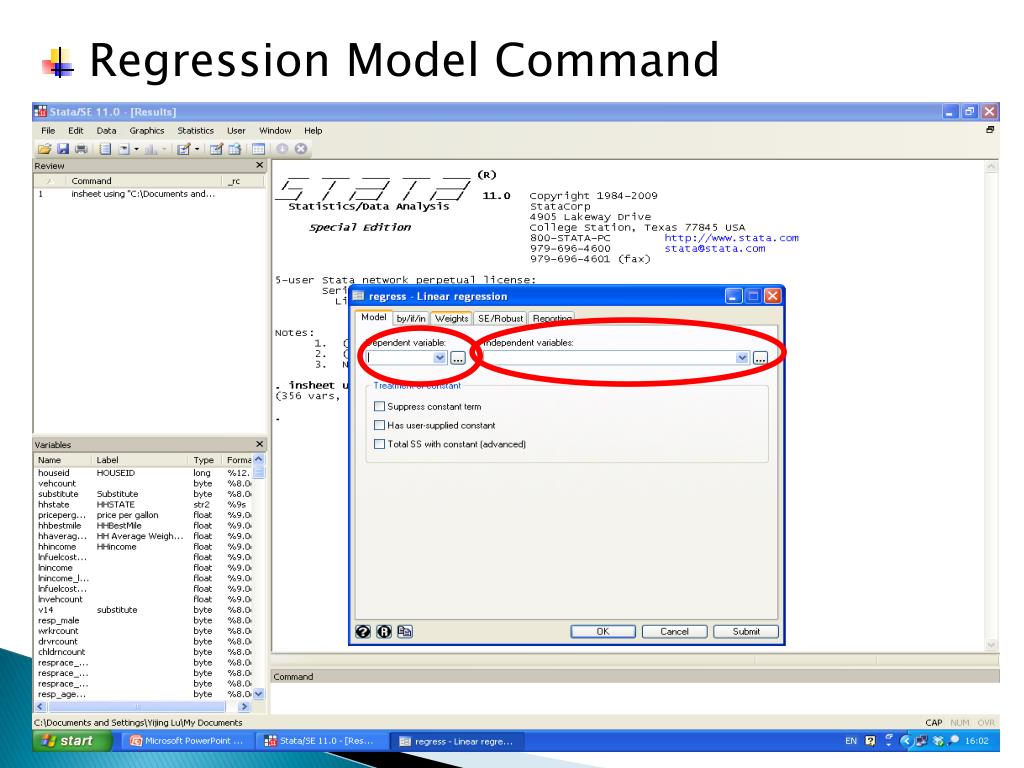
To get around this issue and report all regressions in a nested model in one table, we add an option called store()to the nestregprefix. In this case, it will only output results for the third model that contained four covariates, but not for the two regressions before that. However, you will note that when nested regressions are performed, the command will only output results from the most recent regression run while columns for the results from previous regressions in the hierarchy will not be added. Typically, to output regression tables to Word or Excel, the outreg2command is used. Similarly, the explanatory power of our third regression (Block 3) goes up by 0.0646 (or 6.46%) from the previous model to become 0.3580 (or 35.8%). The last column also shows that this change was an increase of 0.0738 (or 7.38%). When we added ‘weight’ as a new control in the second regression (Block 2), this increased to 0.2934 or (29.34%). For example, the R-squared in the first regression (Block 1), as shown by the fifth column, was 0.2196 (or 21.96%). This table helps in checking how the explanatory power of each of our regressions changed with the addition of the new variable(s). The nested regression method also outputs a table that displays the R-squared for all the regressions run along with the change in this statistics after a new (or a set of new) independent variables/covariates were added. Instead of heaving to run the three regressions separately, the nestregprefix allows us to do so with one command where we can add new coindependent variables/covariates through parenthesis. a regression of ‘price’ on ‘mpg’, ‘weight’, ‘length’ and ‘trunk’). The third model will add on ‘length’ and ‘trunk’ to the list of covariates as well (i.e. The second regression will then regress ‘price’ on ‘mpg’ and ‘weight’.

The first will regress ‘price’ on ‘mpg’ only. In this example, there are three sets of parenthesis indicating that three models will be run. nestreg: reg price (mpg) (weight) (length trunk) The parenthesis can also have one or more variables. The parenthesis will indicate when a new model is to be run with an added covariate. The set of independent variables will be written in parenthesis. The prefix is added with a colon (no space between the prefix and colon) followed by the reg resscommand and the dependent/outcome variable. It is called a prefix because it is added right before a Stata command. Instead of running and reporting all these regressions separately, we can make use of the nested regression prefix called nestregbefore our regression command. Say, we want to add more controls to our model through the ‘length’ and ‘trunk’ variables – we run another regression with these added. Now, if we want to run another regression with a new covariate, ‘weight’, we would typically run another separate regression.

sysuse auto.dtaįirst let’s run a simple regression of ‘price’ on ‘mpg’. How can we display nested/heirarchical regression tables in Stata?įor this example, will use Stata’s built-in auto dataset. We say that models (1) and (2) are ‘nested’ within model (3). Model (3) further added ‘length’ and ‘trunk’ as covariates. Model (1) saw ‘price’ being regressed on ‘mpg’.

A simple example of such a table is given below.Įach subsequent column adds a new variable that was added as a covariate in the regression. Often, each subsequent regression adds one new variable to the list of covariates that an outcome variable is being regressed on. In many published academic papers, we see a single table representing results from various regression models run by the authors. This article will go over how nested or hierarchical regressions are used in Stata.


 0 kommentar(er)
0 kommentar(er)
